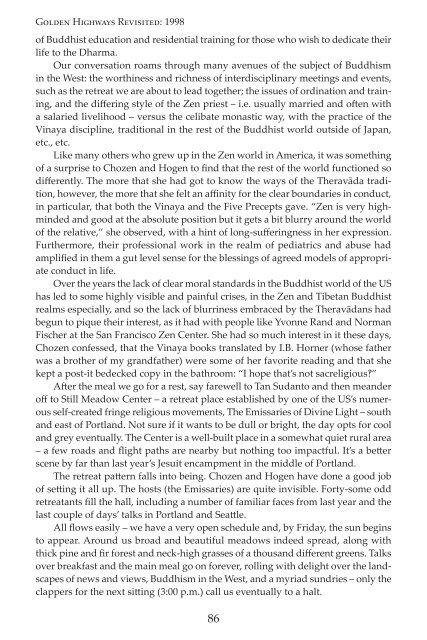Rugged Interdependency - Amaravati Buddhist Monastery
Rugged Interdependency - Amaravati Buddhist Monastery
Rugged Interdependency - Amaravati Buddhist Monastery
- No tags were found...
You also want an ePaper? Increase the reach of your titles
YUMPU automatically turns print PDFs into web optimized ePapers that Google loves.
Golden Highways Revisited: 1998of <strong>Buddhist</strong> education and residential training for those who wish to dedicate theirlife to the Dharma.Our conversation roams through many avenues of the subject of Buddhismin the West: the worthiness and richness of interdisciplinary meetings and events,such as the retreat we are about to lead together; the issues of ordination and training,and the differing style of the Zen priest – i.e. usually married and often witha salaried livelihood – versus the celibate monastic way, with the practice of theVinaya discipline, traditional in the rest of the <strong>Buddhist</strong> world outside of Japan,etc., etc.Like many others who grew up in the Zen world in America, it was somethingof a surprise to Chozen and Hogen to find that the rest of the world functioned sodifferently. The more that she had got to know the ways of the Theravāda tradition,however, the more that she felt an affinity for the clear boundaries in conduct,in particular, that both the Vinaya and the Five Precepts gave. “Zen is very highmindedand good at the absolute position but it gets a bit blurry around the worldof the relative,” she observed, with a hint of long-sufferingness in her expression.Furthermore, their professional work in the realm of pediatrics and abuse hadamplified in them a gut level sense for the blessings of agreed models of appropriateconduct in life.Over the years the lack of clear moral standards in the <strong>Buddhist</strong> world of the UShas led to some highly visible and painful crises, in the Zen and Tibetan <strong>Buddhist</strong>realms especially, and so the lack of blurriness embraced by the Theravādans hadbegun to pique their interest, as it had with people like Yvonne Rand and NormanFischer at the San Francisco Zen Center. She had so much interest in it these days,Chozen confessed, that the Vinaya books translated by I.B. Horner (whose fatherwas a brother of my grandfather) were some of her favorite reading and that shekept a post-it bedecked copy in the bathroom: “I hope that’s not sacreligious‽”After the meal we go for a rest, say farewell to Tan Sudanto and then meanderoff to Still Meadow Center – a retreat place established by one of the US’s numerousself-created fringe religious movements, The Emissaries of Divine Light – southand east of Portland. Not sure if it wants to be dull or bright, the day opts for cooland grey eventually. The Center is a well-built place in a somewhat quiet rural area– a few roads and flight paths are nearby but nothing too impactful. It’s a betterscene by far than last year’s Jesuit encampment in the middle of Portland.The retreat pattern falls into being. Chozen and Hogen have done a good jobof setting it all up. The hosts (the Emissaries) are quite invisible. Forty-some oddretreatants fill the hall, including a number of familiar faces from last year and thelast couple of days’ talks in Portland and Seattle.All flows easily – we have a very open schedule and, by Friday, the sun beginsto appear. Around us broad and beautiful meadows indeed spread, along withthick pine and fir forest and neck-high grasses of a thousand different greens. Talksover breakfast and the main meal go on forever, rolling with delight over the landscapesof news and views, Buddhism in the West, and a myriad sundries – only theclappers for the next sitting (3:00 p.m.) call us eventually to a halt.86
















